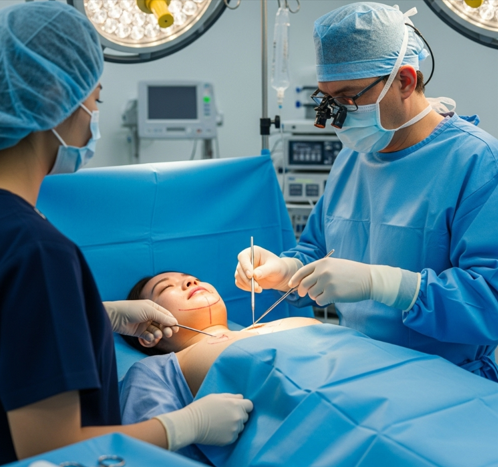Treatment Overview
Prosthetic Breast Reconstruction in Korea is a surgical procedure where breast implants (silicone or saline) are used to restore breast volume and shape after mastectomy or implant removal. This approach is often chosen for patients seeking predictable results, shorter surgery time, and less invasive reconstruction.
Korean plastic surgeons are internationally recognized for their precision, aesthetic expertise, and use of advanced implant technologies, making Korea a leading destination for prosthetic breast reconstruction.
Purpose & Benefits
The primary goal of prosthetic breast reconstruction is to recreate a natural-looking breast while maintaining symmetry and comfort.
Key Benefits:
- Immediate or staged restoration of breast volume
- Customizable breast size and shape according to patient preference
- Less invasive than flap-based reconstruction
- Reduced recovery time compared to autologous tissue procedures
- Can be combined with fat grafting or nipple reconstruction for natural aesthetics
- Minimizes donor site morbidity since no tissue is harvested
Ideal Candidates
Prosthetic breast reconstruction is suitable for patients who:
- Have undergone mastectomy or breast implant removal
- Have sufficient chest tissue to cover the implant
- Desire predictable breast volume and shape
- Prefer shorter recovery and minimal donor site complications
- Are in good health with realistic expectations
Possible Risks & Complications
Even in advanced Korean clinics, potential risks include:
- Capsular contracture (scar tissue around the implant)
- Implant rupture or leakage
- Infection or delayed wound healing
- Nipple or breast asymmetry
- Temporary or permanent changes in sensation
- Rare complications related to anesthesia
Surgical Techniques Used
Korean surgeons employ advanced techniques to ensure natural aesthetics and long-lasting results:
- Submuscular Placement: Implant positioned under the chest muscle for natural contour and reduced visibility
- Prepectoral Placement: Implant placed over the muscle, often supported with acellular dermal matrices (ADM)
- Tissue Expansion: Used in staged reconstruction to gradually prepare the chest wall
- Combination with Fat Grafting: Softens edges of the implant and improves contour
- Scar Minimization: Advanced suturing techniques and strategic incision placement
Recovery & Aftercare
- Light activities resume within 3–5 days
- Swelling and bruising generally subside within 2–3 weeks
- Compression bras recommended for 4–6 weeks
- Avoid heavy lifting and strenuous exercise for 4–6 weeks
- Regular follow-up visits to monitor implant position, symmetry, and healing
Results & Longevity
- Immediate restoration of breast volume and shape
- Long-lasting results with proper post-op care and high-quality implants
- Can achieve natural aesthetics when combined with fat grafting or nipple reconstruction
- Korean surgeons emphasize soft, natural contour and symmetry
- Minimal risk of implant-related complications when using advanced techniques
Treatment Process in Korea
Korea is a leading destination for prosthetic breast reconstruction due to expert surgical skills, advanced facilities, and comprehensive patient care:
- Consultation & Assessment: Evaluate breast and chest wall, discuss implant type and reconstruction goals
- Customized Surgical Plan: Decide on implant type, size, placement (submuscular or prepectoral), and optional fat grafting
- Surgical Procedure: Implant insertion under general anesthesia with meticulous placement for symmetry
- Post-Operative Monitoring: Compression garments, wound care, and pain management
- Follow-Up Appointments: Assess implant position, breast contour, and healing progress
- Optional Combination Procedures: Nipple reconstruction or additional fat grafting
- Medical Tourism Support: English-speaking coordinators, recovery accommodations, and guidance for international patients
Cost Range
The cost of prosthetic breast reconstruction in Korea varies depending on implant type, complexity, and combination procedures:
- Standard Implant-Based Reconstruction: ₩8,000,000 – ₩15,000,000 KRW
(Approx. $6,100 – $11,500 USD) - With Tissue Expansion: ₩10,000,000 – ₩18,000,000 KRW
(Approx. $7,600 – $13,800 USD) - With Fat Grafting or Nipple Reconstruction: ₩15,000,000 – ₩25,000,000 KRW
(Approx. $11,500 – $19,000 USD)
Additional Costs:
- Pre-operative assessments and imaging: ₩150,000 – ₩500,000 KRW ($115 – $380 USD)
- Compression garments and medications: ₩150,000 – ₩400,000 KRW ($115 – $300 USD)
- Follow-up consultations and touch-up procedures: ₩50,000 – ₩200,000 KRW ($40 – $150 USD)
Popular Clinics
Some of the top Korean clinics for prosthetic breast reconstruction include:
- Banobagi Plastic Surgery Clinic – precision implant placement and contour restoration
- JK Plastic Surgery Center – internationally accredited, expert in post-mastectomy reconstruction
- ID Hospital Seoul – advanced tissue expansion and implant reconstruction techniques
- View Plastic Surgery Hospital – emphasizes natural breast shape and symmetry
- Regen Plastic Surgery – combines implant reconstruction with fat grafting for enhanced aesthetics




